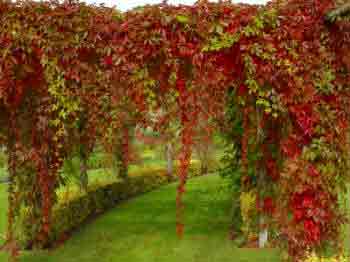Virginia Creeper Parthenocissus quinquefolia, tricuspidata, henryana
There are three basic types of Virginia creeper - as far as I am concerned - all with the same methods of scaling up walls and other robust structures; all with brilliant autumn foliage colour; all being easy to grow. The three Virginia creepers each being superb climbing plants - that qualify for inclusion in this article are
- Parthenocissus quinquefolia (True Virginia creeper) - which has five leaflets which make up each divided palmate leaf.
- Parthenocissus tricuspidata (Boston ivy) - does not have leaflets, but single leaves, each with three lobes
- Parthenocissus henryana (Chinese Virginia creeper) - again with five leaflets joining to make the single divided palmate leaf - often with prominent white viens.
They are deciduous climbers with attractive dense foliage throughout spring and summer, then the dazzling brilliant red in autumn just before leaf fall.
 The
autumn colour display is not too prolonged, but is well worth the
wait. In any event your wall will have an attractive foliage cover for
most all of the 6 months or so growing season from this robust
climbing plant.
The
autumn colour display is not too prolonged, but is well worth the
wait. In any event your wall will have an attractive foliage cover for
most all of the 6 months or so growing season from this robust
climbing plant.
They each have flowers of sorts but to avoid disappointment; a floral display should not be your reason for choice of this essential foliage plant.
Berries may appear after flowering normally dark metallic blue or black.
They should not be eaten as they are said to be poisonous, and in any event will normally be out of reach for hand picking! Birds seem to enjoy them.

Parthenocissus tricuspidata : Parthenocissus
henryana - Summer : Parthenocissus quinquefolia
One thing that binds all three together is the fact that each of these climbers has been awarded the Royal Horticultural Societys AGM - Award of Garden Merit.
Being pedantic, and trying to avoid irate emails, I should also mention that Parthenocissus tricuspidata is more commonly known as the Boston ivy, rather than a Virginia creeper. (It is not true ivy, for ivies are evergreen and belong to the Hedera family.)
How and Where to Plant Virginia Creepers
Virginia creepers are rapid climbing vines that adhere to wall or other surface by way of small sucker pads which are situated on the ends of the tendrils sprouting out from the stems. These tendrils are used in the initial stage to twine around supports in order to move the plant upwards to firmer permanent holding places.
They can grow up walls unaided, together with pergolas, fences and trees. The origins of the Virginia creepers are almost exclusively forests in parts of Asia, the Himalayas and areas of North America. It goes without saying then that Virginian creepers Parthenocissus can be planted in shade areas. But they are also happy on a sunny wall.
Stunning effect when allowed to grow up through a light foliaged tree such as one of the Silver Birches. Blood red autumn foliage against the silver bark and yellow fading leaves of the Birch! Provides one of those moments that makes gardening all the more special.
Self Clinging Vines
Parthenocissus cling to walls either solid brickwork, concrete, or rendered cement walls without causing any damage to stable wall surfaces. The tendril suckers will not dig into soft or unstable cement work, for their quest is to find a solid brick or surface on which to adhere. Ivy (Hedera) on the other hand, will probe any crack in the wall with its aerial root system.
In size order and rapidity of growth cover, my own experience would place them as
1. Parthenocissus tricuspidata at up to 20 metres in around 10 years. Quick Growing Climber
2. Parthenocissus quinquefolia at 12-15 metres in 10 years and onwards after that .
3. Parthenocissus henryana at a more leisurely pace to approx. 10-12 metres in 10 years then continuing after that.
If planting against a wall which is normally dry at the base it will be necessary to water sporadically until settled. It will also be necessary to give the vine a helping hand by way of support until it can climb unaided. After that, and certainly during the second year, such attention will not be required.
Problems with Parthenocissus
All climbing plants come with an often undeserved reputation for causing damage. Just be aware of how quickly they will grow up to and under the eaves if given a chance and treat by pruning accordingly.
Advantages of Parthenocissus
Great home for a wide variety of wildlife, and a sought after potential place for various bird nests.
They will cool down a sunny wall. They will not insulate a cold wall, for they are leafless in the cold winter. Just plant one and await the autumn display.
Propagation of Virginian creepers
The easiest method is by hardwood cuttings in late autumn after leaf fall, or as softwood cuttings in spring.
Pruning of Virginia Creepers
Cut back as required as and when required.
Best Selling Gardening Products
Popular Gardening Sections

Problems
Identify Weeds in The Garden - How to deal with weeds. Diseases and Pest which harm your garden and plants, learn how to prevent, deter and erradicate your garden problems.
Garden Problems
Pruning
Pruning Guide. Shrubs flower better with correct pruning. Many illustrations and examples of what to do - and when. Includes evergreens, roses, flowering shrubs, spring flowering shrubs and pruning for stem effect. This is our most viewed and comprehensive section,
Pruning
Gardening Businesses
Gardening Businesses listed in the UK counties and USA states. County and State Listings of businesses involved in Garden supplies and services. If you wish to be added to the Directory, please send us your information. Having problems, use the search box
Businesses
Gardening
In this section you will learn about Gardening Basics, Containers, Landscaping, Propagation and Soil.
Gardening
Gardening Gifts
Gardening Gifts and Reviews, Read Before you Buy
- Gardening Gifts Ideas
- Gifts For Her
- Gifts For Men
- Power Tool Gifts
- Cheap Gifts
- Personalised Gifts
- Wildlife Gifts
- Family Gifts



